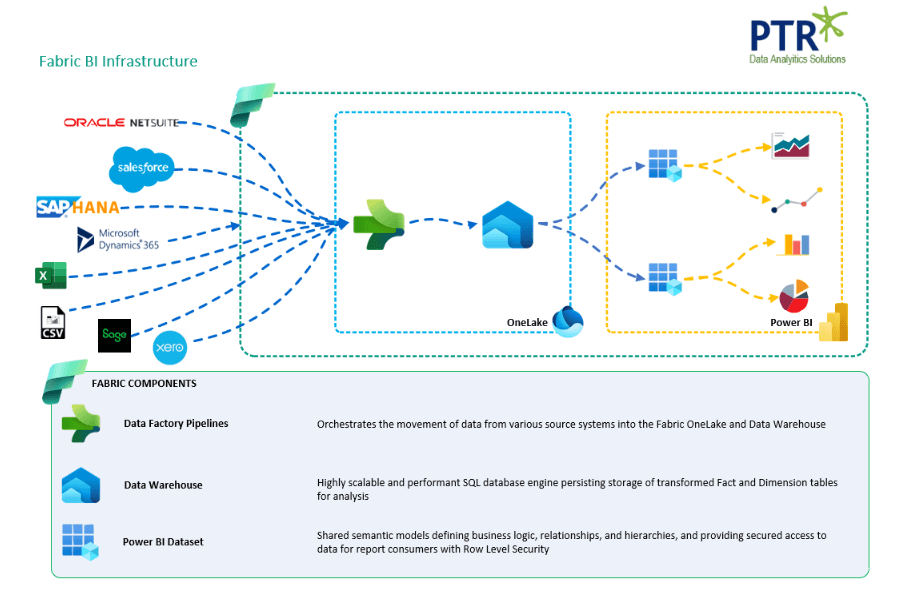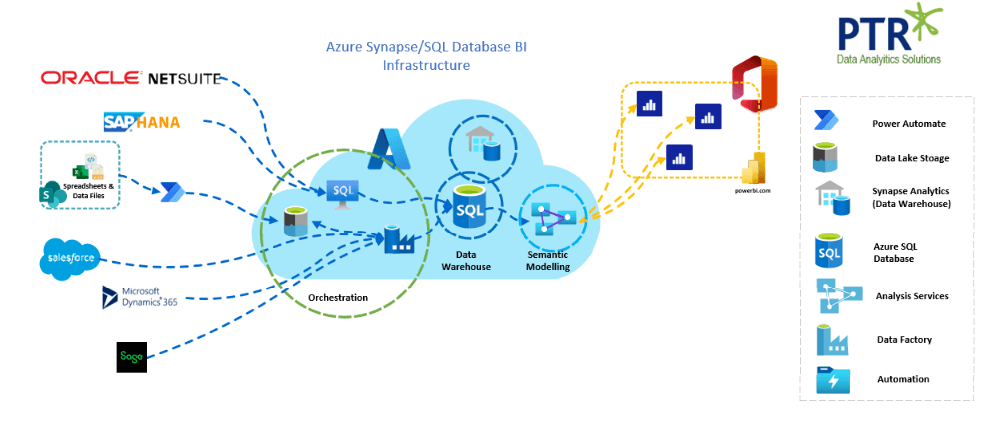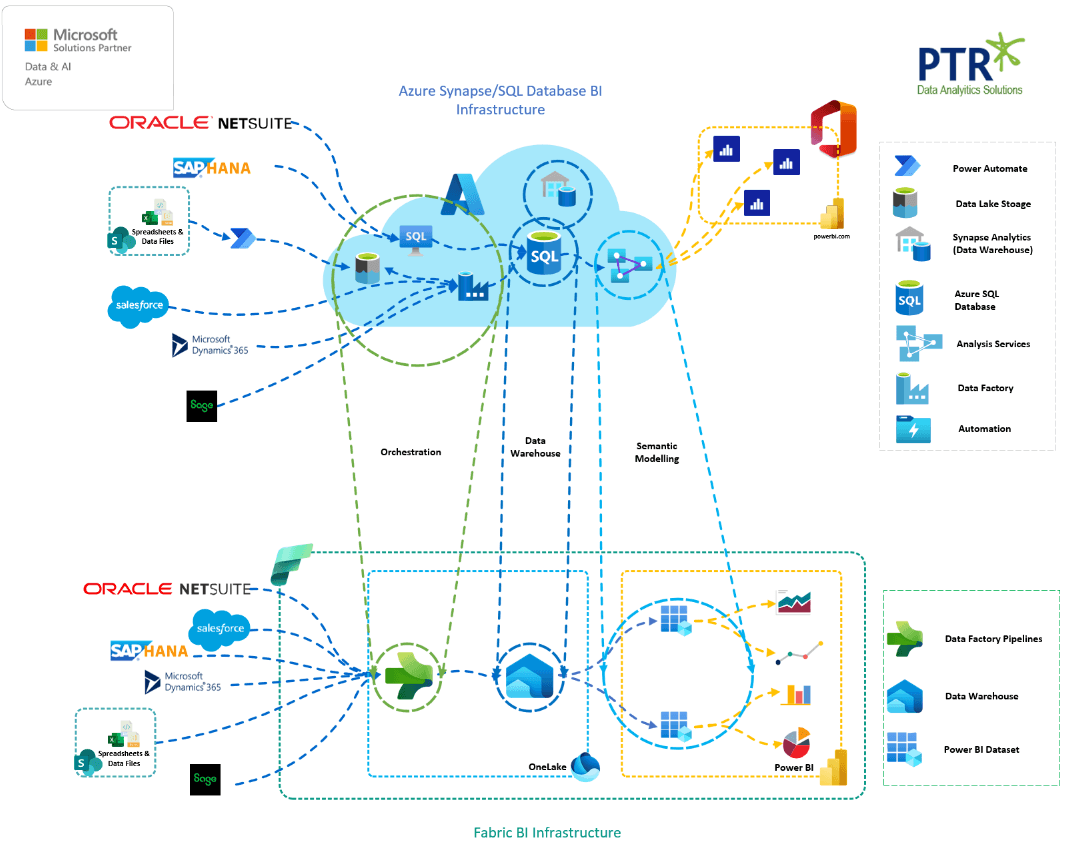Migrating From Azure Data Warehouses & Power BI to Fabric Consultancy Services
Where Do You Start With Your Fabric Migration?
The first place to start is to assess whether you really need to migrate to Fabric right now

Where Do You Start With Your Fabric Migration?
The first place to start is to assess whether you really need to migrate to Fabric right now!
Will it add value to what you already have?
Will it bring significant benefits to your business to justify the expense and time required to migrate?
Will it bring cost benefits to your business?
Do you need it now?
The Fabric world might look like this:

You may have built a successful Business Intelligence solution using Power BI and an Azure data platform. You have possibly got hundreds of Power BI reports and dashboards consuming data from your Power BI shared datasets in use around your organisation. We tend to find that Azure and Power BI data analytics solutions are a moving target, starting fairly well defined and targeted in terms of data to be ingested, dashboards to be delivered and stories to be told, but as your solution becomes more established within your organisation, and more and more business data is integrated into your Data Warehouse and Business Model, the need to scale and handle complex security and business logic makes it necessary to re-evaluate your original objectives and realign them with your now current and future demands and requirements.
It is likely that you started your data journey a few years ago now and technology moves on - there have been significant advances in the functionality now available across the Power BI and Azure data services, in addition to the arrival of the new Microsoft Fabric platform. You will no doubt have developed a Data Strategy at the outset for your Data Analytics journey, but with the speed at which the Microsoft BI platforms evolve you should revisit your Data Strategy at regular intervals.
To assess if Fabric is the right direction for you at this stage a comprehensive review and enhanced data strategy is required to identify where more technically and/or financially appropriate tools are available to ensure scalability and reliability of the platform, along with licensing and cost implications. Where suitable changes are identified, an implementation plan will be required to ensure continuity of existing functionality whilst completing any migration in a timely fashion.
Key objectives for a data strategy review
The key objectives for a data strategy review might include the following:
Consolidate data maintenance procedures into a single orchestration tool.
Ensure long-term scalability and cost effectiveness of data warehouse/lake.
Take advantage of new and enhanced functionality of Power BI, Azure, and Fabric.
Revise modelling strategy to simplify model development, improve reliability, and support complex security requirements.
Retire components that can be consolidated into other services.
Improve collaborative development experience and build robust DevOps practice.
Provide greater administrative control and monitoring.
De-risk change management process, particularly with regards shared datasets.
Your current BI world may look considerably different:

Once you have reviewed your data strategy and have determined that Fabric is the way to go for you the fun starts!
Microsoft Fabric Migration Planning & Implementation
Firstly, look at what platforms and components you currently have in place
Identify the comparable, equivalent or replacing Fabric components and map them to your existing infrastructure
The following diagram shows potential mapping between existing Azure and Power BI infrastructures to Fabric Infrastructures:

Build a migration plan
Build an inventory of all objects to be migrated
Build a mapping document that details live deployment objects to planned Fabric objects
Segment the migration into manageable milestones
Design your Fabric Infrastructure
Ingestion methods to be agreed - dataflows, pipelines or a hybrid?
Location for raw data to be agreed - OneLake - Kusto, Dataset, Lakehouse or Warehouse?
Naming Conventions for all object types
Transformation methods to be agreed - Power Query, SQL, Python
Platform components and tiers required. Tiers are outlined below - F32 and below also require Power BI Pro licenses to get access to Power BI content:
(Latest pricing can be found here)
SKU | Capacity unit (CU) | Pay-as-you-go | Reservation |
F2 | 2 | £206.987/month | £123.132/month ~41% savings |
F4 | 4 | £413.973/month | £246.263/month ~41% savings |
F8 | 8 | £827.945/month | £492.525/month ~41% savings |
F16 | 16 | £1,655.890/month | £985.049/month ~41% savings |
F32 | 32 | £3,311.779/month | £1,970.097/month ~41% savings |
F64 | 64 | £6,623.558/month | £3,940.194/month ~41% savings |
F128 | 128 | £13,247.116/month | £7,880.387/month ~41% savings |
F256 | 256 | £26,494.231/month | £15,760.774/month ~41% savings |
F512 | 512 | £52,988.462/month | £31,521.548/month ~41% savings |
F1024 | 1024 | £105,976.923/month | £63,043.096/month ~41% savings |
F2048 | 2048 | £211,953.846/month | £126,086.192/month ~41% savings |
Create an implementation plan
Ensure no risk to your live environment
Plan the instantiation of the required infrastructure components
Prioritise components and data sources to be migrated
Implement your Fabric solution!
These steps are of course very high level and will have many layers of detail below them. This may be rather daunting for you, but the good news is that we have a portfolio of Fabric Training Courses a team of consultants who can help you every step of the way from your initial assessment through to assisting you with building your Fabric Data Strategy and Implementation plan. Our mentoring style of consultancy means that our Fabric Consultancy Service will lead and mentor your team to take them with us on the Fabric journey, empowering them to take ownership and management of the Fabric solution once implemented.
Share This Post
Frequently Asked Questions
Couldn’t find the answer you were looking for? Feel free to reach out to us! Our team of experts is here to help.
Contact Us